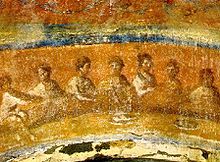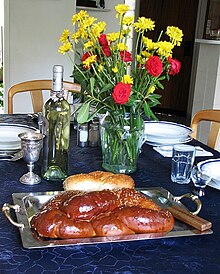Breaking bread
The breaking of bread is an old custom in the Middle East at the beginning of a meal. For this reason it is sometimes equated with the food itself.
In the Christian context, like the laying on of hands, it is also an early Christian communal festive act that Jesus Christ is said to have performed according to the New Testament. There is conceptual overlap with the Eucharist . Although not every biblical breaking of bread is Eucharist, the word breaking of bread is used in some Christian free churches , for example in many congregations of the Brethren movement , as a synonym for the sacrament service .
Judaism
In the Orient, breaking bread is the process that takes place at the beginning of a meal, i.e. a signal from the highest ranking person that one is beginning to eat.
In the Hebrew Bible or the Old Testament , this is a common custom:
- to break your bread to the hungry ( Isa 58,7 EU )
- And bread will not be broken for them when they mourn in order to comfort someone because of a dead person, nor will they be made to drink the cup of consolation because of someone's father and because of someone's mother ( Jer 16.7 EU , cf. also Klgl 4.4 EU ).
Breaking bread is not only community-building, it is also blessing, because a blessing is spoken about the bread (Hebrew: Bracha ). Whoever has received the bread has a share in the blessing, so to a certain extent belongs to the community of blessings.
Breaking bread is a typical act in connection with the Kiddush celebration and the Seder meal on the Passover festival .
Christianity
At Jesus' last supper on the eve of Passover, before he was betrayed, Jesus broke the bread and established the meal as a token of his abiding presence: “Jesus, the Lord, took bread on the night he was delivered and gave thanks , broke the bread and said: This is my body for you. Do this in memory of me! ”( 1 Cor 11: 23–24 EU ) He did the same with wine. According to tradition, the disciples followed this instruction shortly after the death and resurrection of Jesus and perceived the ritual of breaking bread as an opportunity to participate in the “sacramental bread” of the body of Christ ( 1 Cor 10:16 EU ).
Other New Testament narratives were also modeled on breaking bread at the Lord's Supper. In Mt 15,36 EU it says: “And he took the seven loaves and the fish, said the thanksgiving prayer, broke the loaves and gave them to the disciples, and the disciples distributed them to the people” (cf. Mk 8,6 EU ; Mt 14,19 EU , Lk 9,16 EU . The Emmaus disciples, who did not belong to the Twelve Apostles , recognized their Lord by the breaking of bread ( Lk 24,30 EU )).
The breaking of the consecrated host belongs to the rite of holy mass and is understood as a continuation of the act that Jesus performed with his disciples at the last meal.
Early church
The reports of early Christian breadbreaking in the book of Acts are also interesting .
- Acts 2,46–47 EU : Day after day they stood with one accord in the temple, broke bread in their houses and shared meals with one another with joy and simplicity of heart. They praised God and were popular with all the people.
- Acts 2,42 EU : They held fast to the teaching of the apostles and to the community, to the breaking of bread and to the prayers.
- Acts 20,7 EU : When we were gathered on the first day of the week to break the bread, Paul spoke to them, because he wanted to leave the following day; and he extended his speech to midnight.
Further New Testament Bible passages on breaking bread: Acts 27.35 EU , Acts 20.11 EU .
These reports presumably relate to the love feast ( Agape , Jud 12 EU ) of Christians. The Eucharist was originally a part of this love supper ( 1 Cor 11 : 20–34 EU ). Only the intervention of the apostle Paul because of the Corinthian grievances initiated a separation here (1 Corinthians 11:34: “Whoever is hungry should eat at home ...”).
The Didache and Ignatius of Antioch also speak of the invitation to break bread on Sunday. The term can also be found as an expression for the Lord's Supper in the Schleitheim articles of the Reformation Anabaptist movement . Otherwise, the term breaking bread could not establish itself as a name for the Holy Mass .
See also
Individual evidence
- ^ Josef Andreas Jungmann SJ: Missarum Sollemnia. A genetic explanation of the Roman mass. Volume 1, Herder Verlag, Vienna, Freiburg, Basel, 5th edition 1962, p. 226.
- ^ Josef Andreas Jungmann SJ: Missarum Sollemnia. A genetic explanation of the Roman mass. Volume 2, Herder Verlag, Vienna, Freiburg, Basel, 5th edition 1962, p. 369.
- ^ Hans Bernhard Meyer SJ: Eucharist. History, theology, pastoral (church service. Handbook of liturgical science, part 4), Regensburg 1989, ISBN 3-7917-1196-2 , p. 36


